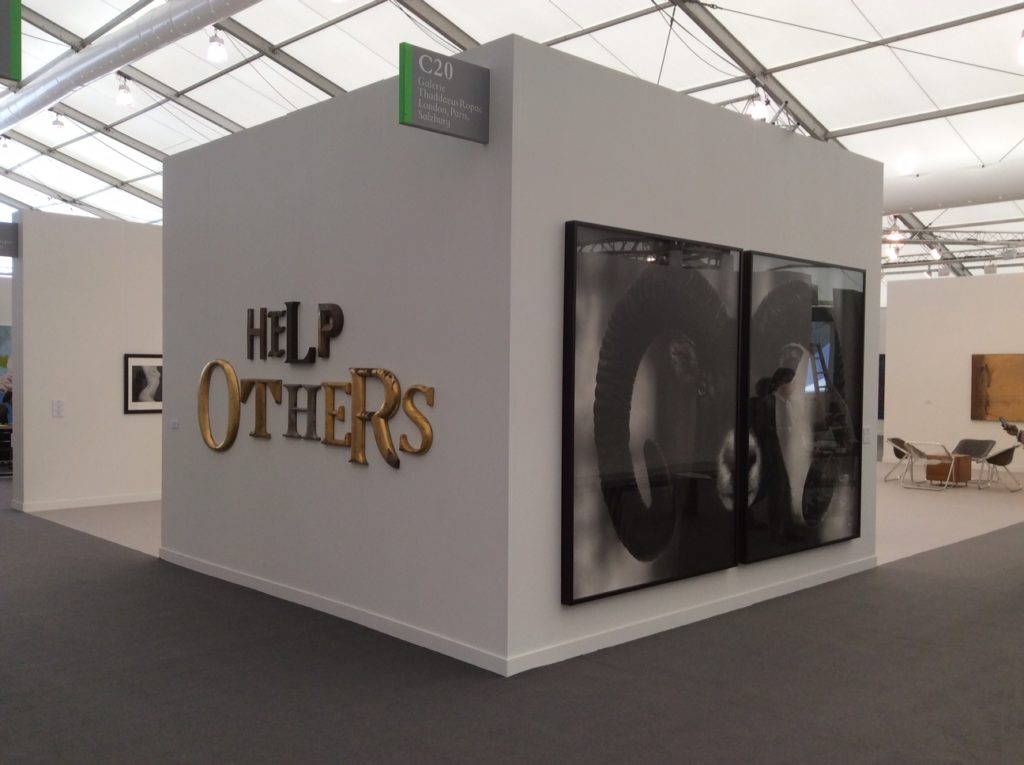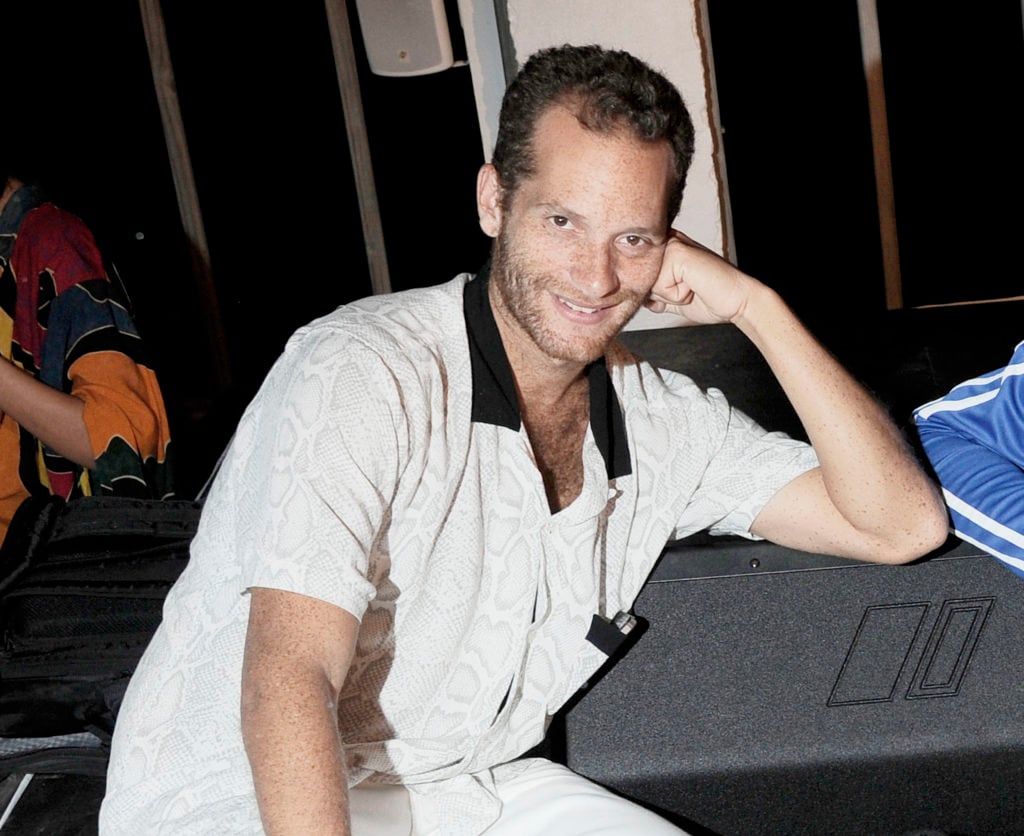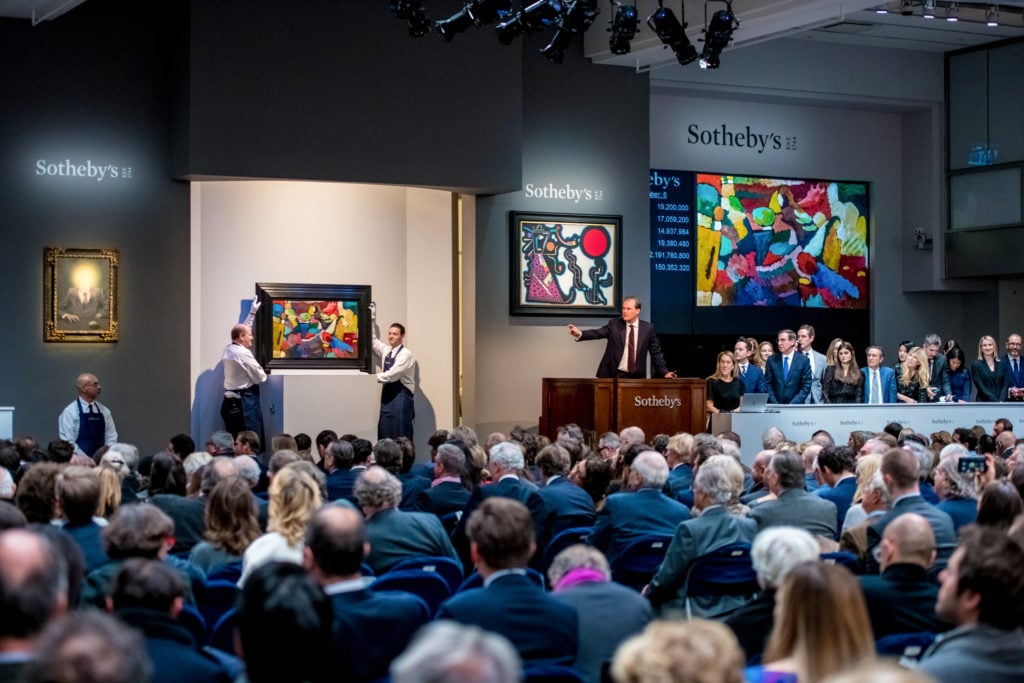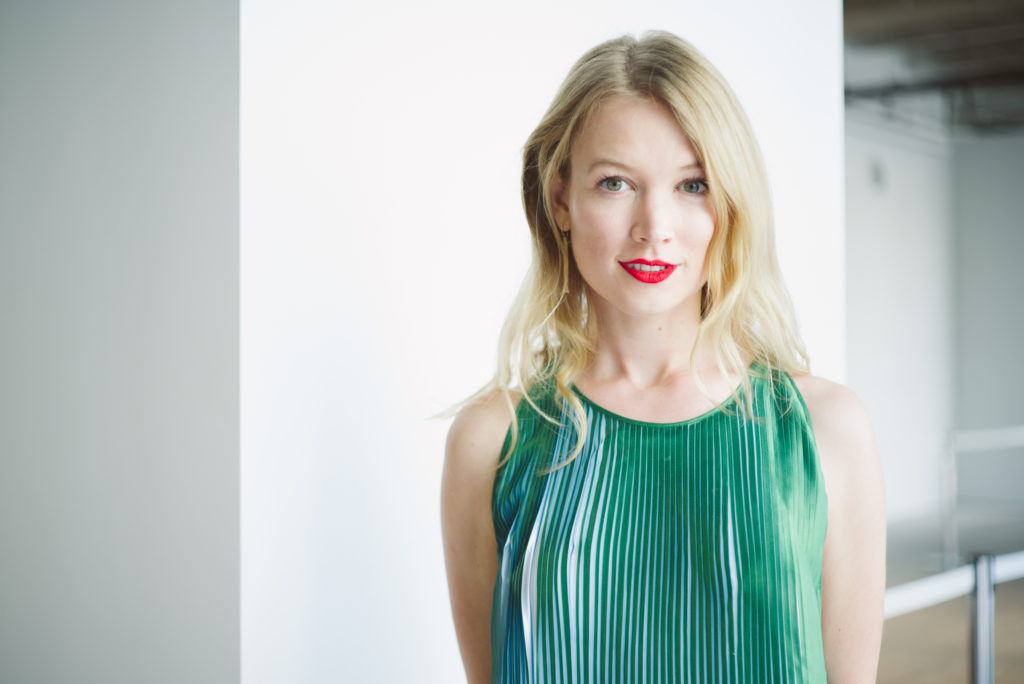Opinion
The Gray Market: How My Eight Highly Specific Art-Market Predictions for 2018 Turned Out (and Other Insights)
Our columnist strikes a blow for art-market accountability by facing up to his 2018 predictions a year later.

Our columnist strikes a blow for art-market accountability by facing up to his 2018 predictions a year later.

Tim Schneider

Every Monday morning, artnet News brings you The Gray Market. The column decodes important stories from the previous week—and offers unparalleled insight into the inner workings of the art industry in the process.
For this week, a special edition…
With January just around the corner, you know what time it is across every province in pundit land: prediction season. But before I join the most courageous, foolhardy, and/or shameless of my keyboard-toting colleagues in guessing what next year has in store for my beat, it’s time to deliver on a pledge I made along with my 2018 prognostications: namely, to go back and assess how those prognostications held up at year’s end.
Below are my eight predictions from this January, with a little added context when the headlines don’t quite explain things on their own. Following each one is my completely subjective evaluation of its accuracy. And if you think this system means I’m less likely to be graded hard than if I turned over the task to someone else, you don’t know me very well.
OK, let’s see precisely how full of crap I was/wasn’t 12 months ago…
The highest-profile casualty in this cohort was NADA New York, whose demise was announced in early August. In place of the fair, NADA states it will instead “dedicate additional resources to gallery programming during the March Art Week” in 2019 and beyond. A similar fate met the Singapore Contemporary Art Show, which got crushed by a falling piano (I mean, metaphorically speaking) in January.
Two other fairs may or may not be dead depending on your beliefs about resurrection. Art Stage Jakarta canceled its 2018 edition, allegedly to due to a conflict with the Asian Games, but pledges to return in 2019. The Moving Image Art Fair “postponed” its 2018 edition in April and still has yet to announce new dates over eight months later.
If you’re a skeptic, that brings the body count to four. The total rises to five if we include the “now-you-see-me-now-you-don’t” Basel edition of the Outsider Art Fair, which was canceled less than two months after its announcement early this year.
Also deserving mention here is Art Basel parent company MCH Group’s decisions “not to proceed” with Art SG in Singapore, as well as to sell its stakes in both the India Art Fair and Art Düsseldorf. However, all three of those fairs will apparently soldier on. Asian market veteran Magnus Renrew already swooped in to acquire MCH’s stake in Art SG, and MCH continues to search for buyers for its interests in the other two events as of my writing.
Still, I don’t think that’s quite enough to push this one over the borderline. I’ll take the L (for “loss,” to those of you not listening to enough hip hop).

Works by Jack Pierson and Robert Longo at Thaddaeus Ropac’s stand at Frieze New York 2018. Photo courtesy of the gallery.
Art Basel (all three fairs), TEFAF (all three fairs), and the Armory Show all held their ground on this front. Technically, so did Frieze, as a spokesperson confirmed last week that the brand’s fairs in London, Los Angeles, and New York require contemporary galleries to have physical exhibition spaces and programs for eligibility.
However, Frieze exhibitors exclusively showing 20th-century art are exempt from this policy “to accommodate certain specialist dealers that operate using different models.” And while this has always been the case at Frieze Masters (and therefore excused that particular fair from this prediction), the caveat also applies to the Spotlight section at Frieze New York—a fact that allowed then-spaceless dealer Nicole Klagsbrun to show at the latter in 2018. (Tif Sigfrids also exhibited in the Frame section at Frieze New York while she was between permanent locations, but the Frieze spokesperson confirmed that Sigfrids still had her Los Angeles gallery when she applied and was already in the process of transitioning to her new Athens, Georgia space when the fair opened.)
All in all, then, there’s no seismic shift underway yet, but I’ll accept prognosticating defeat here on a technicality.
There were no official mergers à la the short-lived Feuer Mesler, my model for the first half of this prediction. But as a canvassing of this year’s NADA Miami proved, there were plenty of extended collaborations forged by galleries beneath the sector’s cloud city. Four sellers from around the world also just announced last week that they will launch La Maison de Rendez-Vous, a collaborative space in Brussels, in January 2019. And for a somewhat posher example, Andrew Kreps, Kaufmann Repetto, and Stefania Bortolami established a long-term co-op space at 55 Walker Street in Tribeca. Still, since the allies in both La Maison de Rendez-Vous and 55 Walker are only adding their new collaborative ventures on top of their individual galleries, the projects aren’t quite enough to fulfill my would-be crystal-balling.
I got closer on the prediction’s second half thanks to longtime photography dealer Steven Kasher’s decision to close his namesake Chelsea gallery and join David Zwirner as a director. But even there, Zwirner didn’t subsume Kasher’s gallery as an entity, meaning the space, artist roster, and operations. He just brought in Kasher (and Kasher’s sales director, Cassandra Johnson) to beef up his personnel.
Still, in the spirit of “too early” being the same thing as “wrong,” I’m tempted to make this same prediction for 2019. Stay tuned to see if I’m brash enough to go through with it!

Aaron Bondaroff in Los Angeles. © Patrick McMullan, photo: Nicholas Hunt/Patrick McMullan.
Gallerist Aaron Bondaroff, known as “A-ron the Downtown Don” during his days as an LES brand ambassador/scenester, resigned from Moran Bondaroff in February after three different women accused him of sexual misconduct. (Bondaroff maintains the encounters were all consensual.) His then-partners in the gallery, brothers Mills and Al Moran, told ARTnews shortly after the story broke that Bondaroff’s ownership stake would be dissolved, ending Moran Bondaroff proper. The Morans soon rebranded and relaunched the gallery as Moran Moran.
Dishonorable mention: Multiple allegations of past misconduct surfaced against legendary British dealer Anthony D’Offay in January. He departed his role as ex-officio curator of Artist Rooms, a touring collection of contemporary art held in partnership between Tate and the National Galleries of Scotland, in December 2017, but the story only emerged in the press the following month. The two museums announced in mid-January that they would “suspend any further contact with Mr. d’Offay until these matters have been clarified.” D’Offay denies the allegations.
As a reminder, the Sotheby’s Prize is “an annual award of up to $250,000 to support and encourage museums to break new ground” by “[facilitating] exhibitions that explore overlooked or under-represented areas of art history.”
My mistake here was to let my fixation on the art world’s usual “follow the leader” tendencies obscure the appreciably different business models being run by the Big Three houses, especially when it comes to non-auction activity.
Sotheby’s has for years been shaping itself into a protean art-services superstructure, with Art Agency, Partners leading a strong advisory and editorial component that gels nicely with the Sotheby’s Prize. (Sotheby’s/AAP’s own Allan Schwartzman is a member of the prize’s six-person jury.)
Christie’s has no interest in that business at this point. True, the house directly sponsors institutional exhibitions in its various markets, but that’s nothing new among the gavel gang. Christie’s primary business goal is to gobble up as much market share in the auction sector as it possibly can, by any means necessary—not to expand its mission.
Phillips, meanwhile, has steadily and smartly built itself up over the past several years by laser-sighting onto the middle market for 20th century and contemporary art, plus establishing a growing business in timepieces and jewelry (or, as the category was repeatedly described in an unnamed art-market report that went from lulling me to sleep to inexplicably throwing me a beret, a hand-rolled cigarette, and a toasty bottle of red, le haute joallerie).
Long story short: Sotheby’s is the only house that wants to do things like this, at least right now. I should have known better. C’est la vie.

Sotheby’s Impressionist and Modern evening sale in New York, November 2018. Image courtesy of Sotheby’s.
Although I get a demerit for leaving the original prediction a little too open-ended—what exactly qualifies as “exorbitant”?—it’s pretty hard to say the figures don’t fit any reasonable definition of the word.
The Economist recently reported (via ArtTactic) that the evening auctions at Christie’s, Sotheby’s, and Phillips New York this November rang up $537 million in guarantees, while The Art Newspaper relayed at the start of the same sales cycle that “projections from one [third-party] guarantor’s in-house analysis team estimate that auction sales worth $3.47 billion worldwide in 2018 will have been covered by a guarantee.” (Also notable: The same source projected that the houses offloaded $2.5 billion of that risk onto third parties.)
But like strictly hanging out with ugly people to try to make yourself look better by comparison, this strategy is going to backfire sooner than later. Will 2019 be the year? Time will tell.
Here’s an unsolicited piece of advice for any aspiring Cassandras and Nostradamuses (Nostradami? Can I do that? Who’s with me?): If you’re going to make predictions, don’t be dumb enough to make them multi-part.
Had I just stuck to the back half of this one, which anticipated a new attraction in the vein of immersive-installation blockbusters like Yayoi Kusama’s Infinity Mirrored Rooms or Big Fun Art like Meow Wolf’s House of Eternal Return, I might have coasted to safety thanks to the debut of the teamLab Borderless Digital Art Museum in Tokyo.
But in typical fashion, I had to push the limits by proposing UTA Fine Arts, Endeavor, CAA, or one of its lesser competitors would further Hollywood agencies’ love affair with contemporary art by facilitating the project. Way to snatch defeat from the jaws of victory, T.
Anyway, lesson learned. Maybe. I hope… (Heavy sigh) Probably not.

Elena Soboleva, David Zwirner’s first Online Sales Director. © Gesi Schilling. Image courtesy of David Zwirner.
Since this feels like a case where the headline could use a little context, I wrote at the time that my definition of a “structural investment in tech” was:
An initiative that transforms—even in some boring day-to-day aspect—how the entity in question does business. Something worth formally announcing, even if wonks like me are the only people who get excited about it at first. Think: A gallery hires a developer to create a virtual-reality “back room” accessible by key collectors; an art fair strikes up a partnership with a leading cybersecurity firm; an auction house curates a selling exhibition exclusively showcasing time-based or interactive new media.
Now, it’s entirely plausible that I just missed a couple of meaningful press releases. But otherwise, the only four relevant events in this arena were Sotheby’s acquisition of Thread Genius, a machine-learning startup tasked with building the house a Netflix-style recommendations engine for artwork and objects; David Zwirner’s hire of Elena Soboleva as online sales director, a newly created position geared toward maximizing the gallery’s digital viewing rooms; Gagosian’s launch of its own temporary, high-end online salesroom in sync with Art Basel this June; and Paddle8’s merger with the Native, a Swiss tech company, to reshape its business around blockchain technology and other millennial-baiting strategies.
Some people might also advocate for the inclusion of Christie’s collaboration with blockchain title registry Artory, in which the house agreed to input provenance info for all works in the Barney A. Ebsworth collection into Artory’s encrypted, decentralized database. But given the extremely limited scope of the collaboration, I think this is more a pilot program than a structural investment—and therefore, not enough to qualify.
All of which means that, in 2018, it still turned out to be a good gamble that mainstream players in the art market would be slow to embrace innovation. It calls to mind a quote from the legendary NFL coach Chuck Noll: “If you don’t like change, you’re going to like irrelevance even less.”
Words to live by in the new year? We’ll all find out soon enough.
That’s all for this edition. ‘Til next time, remember: Hindsight may be 20/20, but it’s irrelevant if you never actually turn around to look.